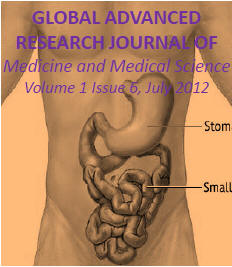|

July 2012 Vol. 1 Issue 6
Other viewing option
Abstract
•
Full
text
•Reprint
(PDF) (183 KB)
Search Pubmed for articles by:
Ugwu GIMG
Other links:
PubMed Citation
Related articles in PubMed
|
|
Global Advanced Research Journal
of Medicine and Medical Sciences
July 2012 Vol. 1(6), pp. 133-138
Copyright © 2012 Global Advanced
Research Journals
Full Length Research Paper
|
Pattern of morbidity and mortality in the newborn
special care unit in a tertiary institution in the
Niger Delta region of Nigeria: A two year
prospective study
G I McGil Ugwu
Department of paediatrics Delta State University
Oghara Delta State Nigeria
E-mail:
gnclinic@yahoo.com;
Phone:
+2348026239010
Accepted
12 July,
2012
|
|
Abstract |
|
To determine the
pattern of morbidity and mortality of admitted
newborns in the Neonatal Intensive Care Unit of
Delta State University Teaching Hospital Oghara.
Newborn morbidity and mortality are still very high
in developing countriets despite significant decline
in developed countries. The quality of newborn care
depends among other things, the establishment of the
special care baby unit, regular audit and evaluation
of services rendered.
All neonates admitted into
the Newborn Intensive Care Unit (NICU) of Delta
State University Teaching Hospital Oghara in Niger
Delta of Nigeria over a two year period between
January 2010 and December 2011, were prospectively
studied. Information documented include the biodata
of each child, the diagnosis, services rendered and
outcome.
A total of 646 neonates were admitted during the
period of review. The male: female ratio was 1.2:1
in favour of the males.(350:296). Of these, 108 were
due to prematurity (16.4% ), 24(3.9% ) due to
intrauterine growth restriction,116 (18.3%) with
birth asphyxia. 228 (35.5%) were due to neonatal
sepsis, 8(1.5%) neonatal tetanus. 60 (9.5%) had
neonatal jaundice while 102 or(14.9 %) were due to
other diseases. Of the 228 with neonatal sepsis,
only in 80 (35.1%) was the sepsis culture proven,
with 47.4% as presumed sepsis and 17.5% of cases,
the neonates had other comorbid states.
The overall mortality rate was 20.3%. The ratio of
male to female deaths was 2.31 with the case
fatality rate also higher in males than females at
26.3% and 14.1% respectively. Sepsis accounted for
25.7% of the deaths, birth asphyxia 24.1%,
prematurity 22.6%.
However the case fatality rate showed neonatal
tetanus to be highest at 50%, Prematurity 27.8%,
birth asohyxia 27.6% and neonatal sepsis 14.9%.
Though more patients seen and died had neonatal
sepsis, the case fatality rate showed neonatal
sepsis to be just slightly above half of that for
prematurity and birth asphyxia which are almost at
par. Case fatality for tetanus remains very high.
Regular auditing of the services in the neonatal
intensive care unit is very essential and reduction
of the neonatal mortality is a must, if the dream of
achieving the 4th millenium development goal of
reducing under 5 mortality by 2/3rd by 2015 can be
attained.
Keywords:
neonate, morbidity, mortality.
|
| |
|
